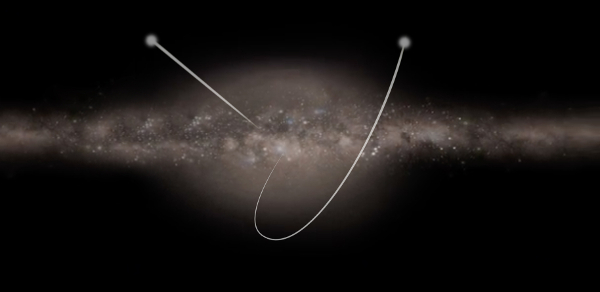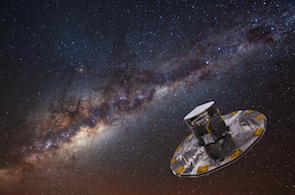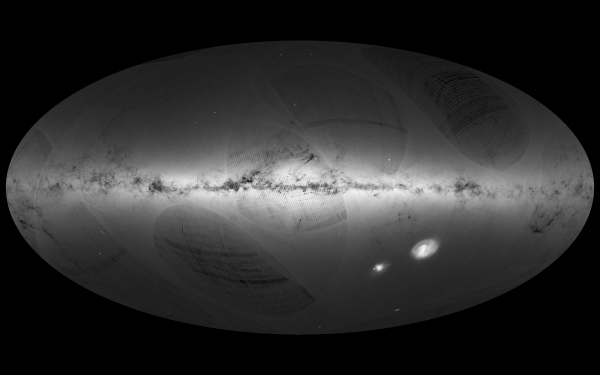Artificial brain helps Gaia catch speeding stars
26 June 2017
With the help of software that mimics a human brain, ESA's Gaia satellite spotted six stars zipping at high speed from the centre of our Galaxy to its outskirts. This could provide key information about some of the most obscure regions of the Milky Way. |
| Stars speeding through the Galaxy. Credit: ESA, CC BY-SA 3.0 IGO |
Our galactic home, the Milky Way, houses more than a hundred billion stars, all kept together by gravity. Most are located in a flattened structure – the Galactic disc – with a bulge at its centre, while the remaining stars are distributed in a wider spherical halo extending out to about 650 000 light-years from the centre.
Stars are not motionless in the Galaxy but move around its centre with a variety of velocities depending on their location – for example, the Sun orbits at about 220 km/s, while the average in the halo is of about 150 km/s.
Occasionally, a few stars exceed these already quite impressive velocities.
Some are accelerated by a close stellar encounter or the supernova explosion of a stellar companion, resulting in runaway stars with speeds up to a few hundred km/s above the average.
A new class of high-speed stars was discovered just over a decade ago. Swooping through the Galaxy at several hundred of km/s, they are the result of past interactions with the supermassive black hole that sits at the centre of the Milky Way and, with a mass of four million Suns, governs the orbits of stars in its vicinity.
"These hypervelocity stars are extremely important to study the overall structure of our Milky Way," says Elena Maria Rossi from Leiden University in the Netherlands, who presented Gaia's discovery of six new such stars today at the European Week of Astronomy and Space Science in Prague, Czech Republic.
| Catching speeding stars. Click here for details and large versions of the video. Credit: ESA/Gaia/DPAC, CC BY-SA 3.0 IGO |
"These are stars that have travelled great distances through the Galaxy but can be traced back to its core – an area so dense and obscured by interstellar gas and dust that it is normally very difficult to observe – so they yield crucial information about the gravitational field of the Milky Way from the centre to its outskirts."
Unfortunately, fast-moving stars are extremely difficult to find in the stellar haystack of the Milky Way, as current surveys list the speed of at most a few hundred thousand stars.
 |
| Artist's impression of Gaia. Credit: ESA/ATG medialab; background image: ESO/S. Brunier |
To find them, scientists have been looking for young, massive stars that would stand out as interlopers in the old stellar population of the Galactic halo. Given away by their out-of-place age, these stars are likely to have received an extra kick to reach the halo. Further measurements of their speeds and estimates of their past paths can confirm if they are indeed hypervelocity stars that were shoved away from the centre of the Milky Way.
So far, only 20 such stars have been spotted. Owing to the specific selection of this method, these are all young stars with a mass 2.5 to 4 times that of the Sun. However, scientists believe that many more stars of other ages or masses are speeding through the Galaxy but remain unrevealed by this type of search.
The billion-star census being performed by Gaia offers a unique opportunity, so Elena and her collaborators started wondering how to use such a vast dataset to optimise the search for fast-moving stars.
After testing various methods, they turned to software through which the computer learns from previous experience.
"In the end, we chose to use an artificial neural network, which is software designed to mimic how our brain works," explains Tommaso Marchetti, PhD student at Leiden University and lead author of the paper describing the results published in Monthly Notices of the Royal Astronomical Society.
"After proper 'training', it can learn how to recognise certain objects or patterns in a huge dataset. In our case, we taught it to spot hypervelocity stars in a stellar catalogue like the one compiled with Gaia."
As part of Elena's research project to study these stars, the team started developing and training this program in the first half of 2016, in order to be ready for the first release of Gaia data a few months later, on 14 September.
 |
| Gaia's first sky map. Credit: ESA/Gaia/DPAC. Acknowledgement: A. Moitinho & M. Barros (CENTRA – University of Lisbon), on behalf of DPAC. |
Besides a map of over a billion stellar positions, this first release included a smaller catalogue with distances and motions for two million stars, combining observations from Gaia's first year with those from ESA's Hipparcos mission, which charted the sky more than two decades ago. Referred to as the Tycho–Gaia Astrometric Solution, or TGAS, this resource is a taster for future catalogues that will be based solely on Gaia data.
"On the day of the data release, we ran our brand new algorithm on the two million stars of TGAS," says Elena.
"In just one hour, the artificial brain had already reduced the dataset to some 20 000 potential high-speed stars, reducing its size to about 1%.
"A further selection including only measurements above a certain precision in distance and motion brought this down to 80 candidate stars."
The team looked at these 80 stars in further detail. Since only information on the star's motion across the sky are included in the TGAS data, they had to find additional clues to infer their velocity, looking at previous stellar catalogues or performing new observations.
"Combining all these data, we found that six stars can be traced back to the Galactic Centre, all with velocities above 360 km/s," says Tommaso.
Most importantly, the scientists succeeded at probing a different population from the 20 stars that were already known: the newly identified stars all have lower masses, similar to the mass of our Sun.
One of the six stars seems to be speeding so fast, at over 500 km/s, that it is no longer bound by the gravity of the Galaxy and will eventually leave. But the other, slightly slower stars, are perhaps even more fascinating, as scientists are eager to learn what slowed them down – the invisible dark matter that is thought to pervade the Milky Way might also have played a role.
While the new program was optimised to search for stars that were accelerated at the centre of the Galaxy, it also identified five of the more traditional runaway stars, which owe their high speeds to stellar encounters elsewhere in the Milky Way.
"This result showcases the great potential of Gaia opening up new avenues to investigate the structure and dynamics of our Galaxy," says Anthony Brown from Leiden University, a co-author on the study and chair of the Gaia Data Processing and Analysis Consortium.
The scientists are looking forward to using data from the next Gaia release, which is planned for April 2018 and will include distances and motions on the sky for over a billion stars, as well as velocities for a subset.
Dealing with a billion stars, rather than the two million explored so far, is an enormous challenge, so the team is busy upgrading their program to handle such a huge catalogue and to uncover the many speeding stars that will be lurking in the data.
"The sheer number of stars probed by Gaia is an exciting but also challenging opportunity for astronomers, and we are glad to see that they are happily embracing the challenge," says Timo Prusti, Gaia project scientist at ESA.
Notes for Editors
"An artificial neural network to discover Hypervelocity stars: Candidates in Gaia DR1/TGAS," by T. Marchetti et al., is published in Monthly Notices of the Royal Astronomical Society.
These results were presented today at the European Week of Astronomy and Space Science in Prague, Czech Republic.
For further information, please contact:
Elena Maria Rossi
Leiden Observatory
The Netherlands
Tel: +31 6 8112 1440
Email: emr![]() strw.leidenuniv.nl
strw.leidenuniv.nl
Tommaso Marchetti
Leiden Observatory
The Netherlands
Tel: +31 6 4776 9205
Email: marchetti![]() strw.leidenuniv.nl
strw.leidenuniv.nl
Anthony Brown
Leiden Observatory, Leiden University
Leiden, The Netherlands
Email: brown![]() strw.leidenuniv.nl
strw.leidenuniv.nl
Timo Prusti
Gaia Project Scientist
European Space Agency
Email: timo.prusti![]() esa.int
esa.int
Markus Bauer
ESA Science and Robotic Exploration Communication Officer
Tel: +31 71 565 6799
Mob: +31 61 594 3 954
Email: markus.bauer![]() esa.int
esa.int




